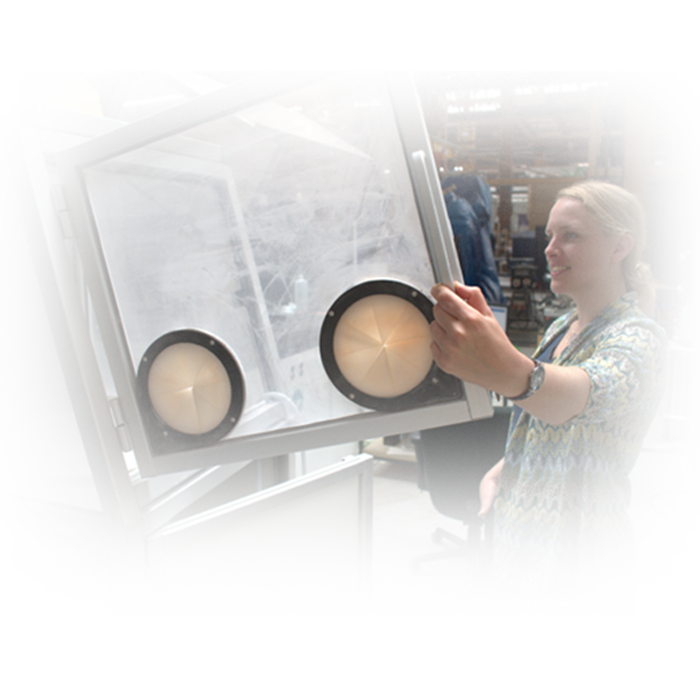In this article, we will discuss the depowdering process of binder jetting, taking as an example our Limestone powder. In binder jetting, droplets of binder liquid get released onto a powder bed to bind the powder and form an object. Since the powder not being printed onto acts as a support, residues of material will need to be cleaned. Keep reading if you want to know more about the depowdering process for CONCR3DE's printers!
Depowdering process
In binder jetting, after the printing process has been completed, the printed parts are enclosed in the printing bed, surrounded by loose powder. The process in which the excess material is removed from the object is called depowdering. For our Limestone powder, the process is very easy. After a print is complete, the parts will be inside the printing bed, surrounded by loose powder. If the next print job will use the same material as the one that just finished, then most of the unbound powder can be removed directly inside the print box - as it can be fully recycled. If the material will change, we advise using our Depowdering Box. The Box can be placed on top of the printing bed and be easily removed together with its contents: the printed parts and the unbound powder. The Depowdering Box is very useful for increasing the green strength of certain materials – typically ceramics and metals, making these parts easy to handle and depowder before further post-processing. When the object is removed from the printing bed or the Depowdering Box, it will have substantial residues of powder. From this point, you have two choices.
The first one is depowdering by hand. An operator (or more than one) needs to delicately remove the excess material with brushes of different sizes. We offer a set of depowdering tools, including brushes, scrapers, and everything else required for completing this phase. However, depowdering by hand is a process that requires several people to hold the object in the air, rotate it, and clean it.
The second choice is using our Depowdering Station. By using this add-on, the depowdering process can be done by only one person and the powders can be contained in a protected environment. It also facilitates the removal phase, as it uses compressed air. After most of the Limestone powder is removed, the parts can be placed in water for at least 24 hours to remove the superficial dust left on the object. We advise leaving it in water for longer to achieve a better surface finish. After that, the object can be infiltrated by common methods seen in the stone and concrete industry, for example, waterglass.
Depowdering Station
At CONCR3DE, we not only develop binder jetting 3D printers, but keep a keen eye on the integral production process. That is why we created our Depowdering Station. It was designed by our engineer Arine Burema to facilitate the depowdering process. It has a clever design, that allows a single operator to complete the depowdering process as it has an air compressor and a vacuum that make the process much easier. After a print is completed and most of the powder has been scraped off in the printing box, the objects can be transferred to the Depowdering Station. The parts are placed on top of a rotating plate, which proves to be particularly useful for heavier objects. There are two holes for inserting your hands and isolating the loose powders that would inevitably be dispersed in the air.
In Arine’s words: “Inside the Station, you can use the brush but mostly you will be using the compressed air”. The air compressor is placed on the bottom of the station, in a dedicated closet. Compressed air facilitates the depowdering process as it can easily remove the powder that is stuck in small details or places where a brush would not fit. The user can spin the rotating plate, and in the meantime clean with the compressed air where it is needed. Next to the plate, in a corner, a vacuum connection is provided. By turning on the vacuum, any loose powders in the Station's chamber can be easily removed for a better view of the part that is being depowdered. The vacuum also serves the purpose of keeping the environment clean from powders that might potentially be harmful to breathe.
Arine has designed the Depowering Station to improve the efficiency of our printers in a manufacturing setting. She says: “In a production line, removing the powder inside the printer is not ideal. This is why you would want to take out the batch as soon as the print is finished and place it in the Depowdering Box”. As mentioned before, this iteration would save time, make the job easier, and be more efficient on the production line.
Summary
Depowdering is a fundamental step in the post-processing treatment of objects produced with binder jetting. It makes printed parts easier to handle and enhances their mechanical characteristics. The skills and number of people required to depowder varies based on the equipment at disposal. The minimum requirement is a set of depowdering tools that we offer to our clients. With a Depowdering Station, a single operator can complete this process. Without it, it could take up to 3 people. If the parts also have a considerable weight, the process without a Depowdering Station, which includes a rotating plate for movement, becomes physically strenuous. For what concerns the skills needed, basically anybody can do it. It is important to treat the objects with care and handle them properly, as they might still need to undergo other post-processing treatments to improve their mechanical properties. A pair of gloves and protective glasses are always mandatory when depowdering, while other safety measures might be advised depending on the material characteristics.
If you have questions about the depowdering process or our CONCR3DE printers, contact our team of experts by clicking here.
Would you like to know more? Contact our team today!
